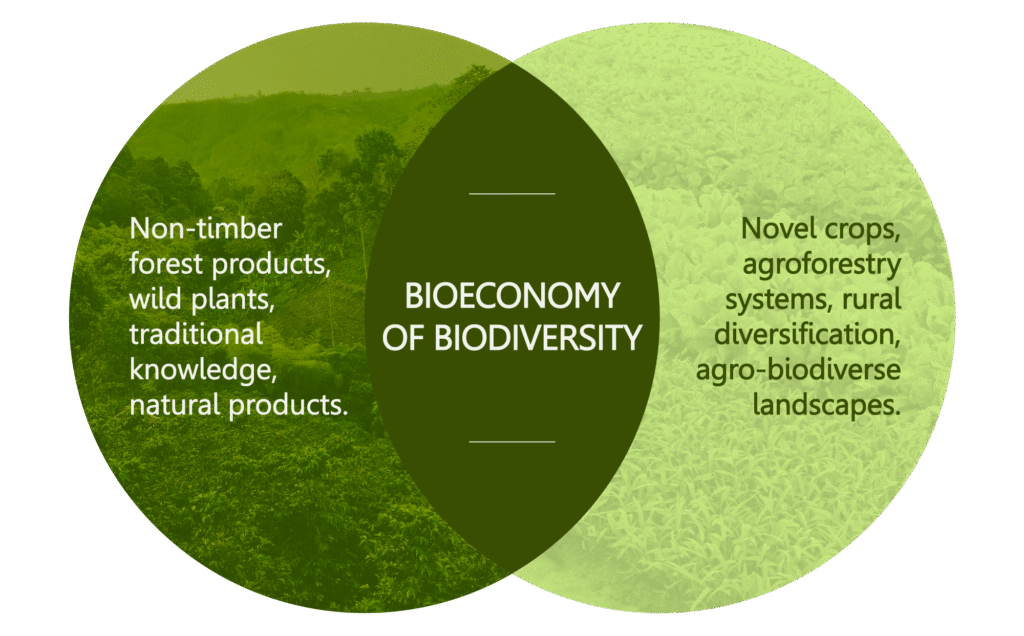RESEARCH AND ACTION APPROACHES

The NEXUS network focuses on territorial bioeconomy systems of biodiversity and encompasses diverse areas of applied, contextualized and transformative research that co-create knowledge and promote processes of positive and impactful change in the territories. The productive systems addressed are those corresponding to the use of biodiversity in its wild state and agro-biodiverse systems, understanding that these systems are interrelated and co-exist in the same territories.

BIOECONOMIES BASED ON WILD PLANT BIODIVERSITY
This area covers production systems, value chains and webs based on the use of wild plants from local biodiversity. Within this category are non-timber forest products (NTFP) systems, which are highly rich in traditional knowledge and in the multi-purpose use of native plants.
See more
Challenges and opportunities for research, development and innovation
There are ample opportunities to strengthen the value chains of products based on wild biodiversity, particularly non-timber forest products (NTFPs), through research and development initiatives in three strategic areas:
1. Knowledge and sustainable access to NTFPs: There is great potential for expanding ecological and biological knowledge of the species, which can encourage more sustainable harvesting practices. The development of technical advisory services and the promotion of domestication processes offer promising ways to ensure the long-term availability of these resources. In addition, innovation in technologies for safe and efficient harvesting, as well as pre-processing techniques at source, can significantly improve the quality and conservation of products.
2. Value-added processing and transformation: Strengthening investment in infrastructure and promoting the industrial development of NTFPs opens possibilities for improving product quality and meeting the standards of demanding markets. Research aimed at exploring the physicochemical properties and bioprospecting potential of native species can drive innovation and diversification of supply. In addition, encouraging local processing can generate employment, boost rural economies and promote the retention of value in the territories of origin.
3. Market access and promotion strategies: There is a great opportunity to develop market research to improve understanding of volumes, prices, consumer profiles and emerging trends. In parallel, the design of awareness campaigns can increase demand and recognition of these products. Finally, the creation of a specific national strategy to promote access to NTFP markets could improve their positioning and competitiveness vis-à-vis traditional chains.
AGRO-BIODIVERSITY BIOECONOMIES
This area embraces production systems, value chains and webs based on agro-biodiversity that promote integrated agricultural practices such as agro-forestry making use of local biodiversity, generating benefits for the resilience and multi-functionality of agricultural systems
See more
Challenges and opportunities for research, development and innovation:
Analysis of agrobiodiversity-based value chains reveals important opportunities for innovation and progress, especially in the cultivation of new perennial plants used as non-timber forest products (NTFPs) and in the post-harvest processing and transformation stages:
1. Advancing cropping systems: There is great potential to expand ecological and agronomic knowledge of native species within agro-pastoral and silvicultural systems. Research in this area can improve sustainable cropping practices and increase resistance to soil degradation. In addition, the development of standardized protocols for the production of plant reproductive material offers a valuable pathway to conserve, improve and expand native species, allowing for more targeted and effective breeding strategies.
2. Value creation through transformation: Promoting scientific research on the functional and bioprospecting properties of indigenous crops can open new pathways for product innovation. Specific programs to support value-added processing can help scale up agrobiodiversity-based products beyond the experimental stage. In addition, advancing technologies for the use of agricultural residues depict an interesting opportunity to improve the circular use of resources and increase processing efficiency.
3. Strengthen market integration: Although less frequently addressed, improving access to market information, fostering stakeholder coordination, and promoting the availability of diverse and nutritious food products can help scale up agrobiodiversity-based products beyond the pilot phase


